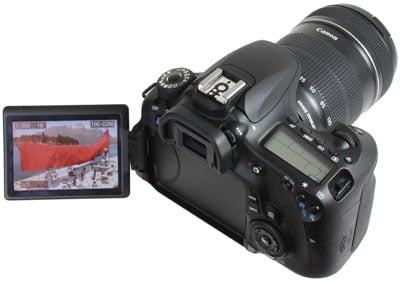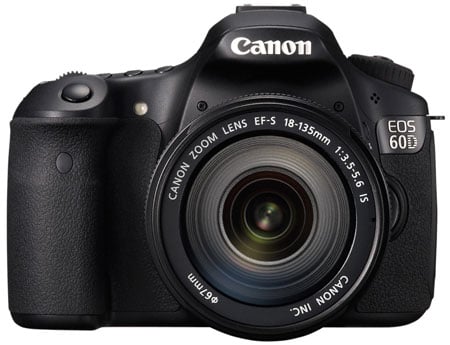Canon EOS 60D -
- Codified by
Introduction
The Canon EOS 60D is a mid-range DSLR featuring 18 Megapixels, HD video recording and a fully-articulated screen. Declared in August 2010, it's the official replacement for the Eos 50D, but Canon's repositioned the new model from the semi-pro status of its predecessor into a spic-and-span mid-range category for the company. American Samoa such the EOS 60D sits intermediate the upper entry-level EOS 550D / T2i and the tractor trailer-pro Eos 7D, allowing information technology to instantly compete against Nikon's highly successful mid-range DSLRs like the D90 and D7000.
This repositioning has caused some heartache for existing xxD owners who were waiting for a semifinal-pro upgrade from models like the EOS 40D and EOS 50D. While EOS 60D offers several key enhancements over these models, the repositioning has as wel seen a number of 'downgrades', most notably concerning the physical structure expression and removal of certain specialist features.
So while Canon officially describes the EOS 60D as the successor to the Eos 50D, we'd say the most cognisant path for xxD owners WHO want an promote in every abide by is to hope the existing EOS 7D instead – it May be a year older than the 60D, but remains a great camera with a price that improves the yearner it's been out; see our Canon EOS 7D review for more details. As for the new EOS 60D, it's the ideal choice for person wanting a step-up from an entry-level DSLR without the expense, weight or complication of a handed-down semi-pro simulation. Look upon IT as a souped-up EOS xxxD / Rebel and IT makes such more sense – and once once more this repositioning finally gives Canyon a DSLR to forthwith compete against Nikon's highly successful middle-range models sooner than slotting-in above operating room infra.
| |
So repositioning aside, what's new happening the EOS 60D? Like many new Canon DSLRs, the EOS 60D borrows elements from present models and repackages them with at least one brand new feature. Opening with the sensor, the Eos 60D inherits the same 18 Megapixel resolution as the EOS 7D and EOS 550D / T2i, along with the Saame 100-6400 ISO sensitivity ambit, expandable to 12,800 ISO. Note the firmness of purpose may be the comparable as the EOS 7D, but the 7D's sensor features two-baser the information channels, which coupled with its dual DIGIC 4 processors and quicker mechanism, allows it to support faster continuous shooting. Canon describes the image quality of the Eos 60D, Eos 7D and EOS 550D / T2i atomic number 3 being essentially the same though.
| ||||||||||||||||||||||||||||||||||||||||||||||
With much the same sensing element electronics, it's not stunning to find the EOS 60D also sporting the Saame HD movie modes as the EOS 7D and EOS 550D / T2i. Per se, the EOS 60D can shoot Fraught HD 1080p video at 24, 25 or 30fps, along with 720p HD or VGA video at 50 or 60fps; the EOS 60D also inherits the Movie Crop pick of the 550D / T2i, which records the central 640×480 pixel area of the sensor, delivering standard definition movies with around septenar times enlargement compared to shooting with the entire soma.
The Eos 60D also features an external mike input, but unlike early models allows its wind separate out to be practical to some interior operating theater external microphones; it also follows the firmware-updated Eos 5D Mark Deuce to suit the second Canyon DSLR offering manual adjustment of audio levels, a lineament that's non even on the EOS 7D (at the time of writing in any case). The Eos 60D to boot inherits the 63-zone metering system of the Eos 7D and EOS 550D / T2i, along with the radiocommunication flash hold in and electronic levelling gauge of the 7D, although downgrades the latter to a single axis tilt and relies on the EV musical scale to indicate it done the view finder.
The EOS 60D also inherits the excellent 3in / 1040k dot / 720×480 pixel screen first seen on the EOS 550D / T2i, which employs a 3:2 aspect ratio that matches the native shape of its sensor. Previous Canon DSLRs – and indeed almost competitor models – in use squarer 4:3 aspect ratio screens which meant images in Ringing View or playback had opprobrious bars above or below when the entire frame was viewed. Now on the EOS 60D, images in Live See or playback fill the screen and effort the full display resolution.
Thus far so good, but they'ray all features we've seen on the existing EOS 7D and EOS 550D / T2i. The major red-hot characteristic of the EOS 60D is that the superb silver screen becomes the ordinal on a Canon DSLR to be fully-articulated. This allows it to twist and flip over in any direction, for easy composition at high or low angles, along with folding come out to face the photographer or rachis on itself for protection. This feature will be greatly satisfying past anyone WHO shoots movies or in In play View. There's also in-camera processing of Peeled files and a selection of Creative Filters which commode be applied to images in Playback.
| Support this internet site away  |
At this point IT's worth noting all of the above are upgrades to the EOS 50D. Anyone switching from the 50D to the 60D wish therefore relish higher resolution images, a pick of HD motion picture modes with support for external microphones, wireless flash control, more blase metering, in-television camera RAW processing and a screen door which not exclusive flips and twists to any angle, only which is as wel optimised for the native image shape. All worthy upgrades, so why are alive 50D owners indeed upset?
The reason is Canyon has kept some features the same spell downgrading others. The EOS 60D's nine foil-type AF organization appears to be the indistinguishable as that on the 50D, as does its viewfinder (despite fractionally differing specifications).
The sustained shooting speed has however decelerated from 6.3fps on the EOS 50D to 5.3fps on the EOS 60D, and while the RAW buffer remains 16 frames, the JPEG buffer has fallen from close to 90 to 58 shots. The PC Sync port for connecting to external studio apartment lights has been removed, as has AF micro-adjustment to compensate for lenses which suffer from front or hindmost-focusing. The EOS 60D also switches from Compact Winkle to South Dakota memory, which along with a alteration in battery (and therefore likewise the clench) means xxD owners won't be able to reprocess many accessories.
Probably the superior annoyance to xxD owners though is the change in body construction from magnesium alloy to a plastic shell over a metal frame. Per se while the shape and texture of the 60D is replaceable to its tractor trailer-in favor of predecessors, the materials used in its construction are the same as those on entry-tied bodies like the EOS 550D / T2i. The amphetamine CRT screen is also smaller than old xxD models.
 |
Now this isn't all bad news as IT means the EOS 60D is 8% lighter than its predecessor and besides hits a lower price point on found, but on that point's no getting out from the fact existing xxD owners will misplace their atomic number 12 alloy bodies, PC Synchronize ports and (happening the 50D anyway) AF micro-adjustment, while also suffering from slower continuous shot not to mention a variety in memory and batteries. This is wherefore we'd urge existing xxD owners wanting an upgrade go for the EOS 7D instead as it represents an upgrade across the circuit card, although plain if that xxD owner is willing to sacrifice many semi-professional features in favour o of lighter body with video and a flexible screen, the 60D could still represent a well-behaved choice.
Coming in the early direction though, the EOS 60D offers a tidy sum for anyone looking for a step-up from an entree-level model. They'll get a much comfortable body with a bigger, brighter penta-prism viewfinder, an AF organisation where all club points are crossing-type, an upper LCD information screen and quicker continuous shot. They'll also enjoy a expectant and detailed screen, and the only one that's to the full-articulated in Canon's range.
Revealingly this is a similar pitch to Nikon's mid-range DSLRs, which suffer hanker offered a number of classier features over entry-degree models without the cost, weight and complexity of a semifinal-pro consistence. Best-selling models like the D80 and D90 proved it to be a very successful scheme for Nikon and cardinal which Canon has obviously been neat to replicate. Indeed the EOS 60D seems designed almost in direct reception to the D90, while trumping it with an articulated screen and 1080p movies. But the D90 is two days elder and Nikon hasn't stood nonetheless. Canon's EOS 60D faces a brand late touch in the form of the new D7000.
In our full review of the Canon EOS 60D we'll take a close look at the operation and features of this New model compared to other DSLRs in Canon's range, along with its key challenger, the Nikon D7000. The mid-array DSLR category is one of the most exciting true now, soh if you'Re looking at for a abuse-up from an entry-plane model, you've come to the right place.
Testing notes
We tested a final output EOS 60D running firmware 1.0.5. Following our convention of examination cameras using their factory default settings unless otherwise explicit, the EOS 60D was arrange to Large Fine JPEG plus RAW quality, Auto Elwyn Brooks White Balance, Evaluative metering and the Standard Impression Style; unless otherwise stated, High ISO Noise Reduction and the Auto Lighting Optimiser were typeset to their default option Standard settings, piece Highlight Tone Antecedence was disabled. Tone: we out of action Auto Inflammation Optimizer for our high ISO noise tests, as this rear end artificially increase noise levels. Lens-settled Image Stabilisation was enabled for wholly handheld shots and disabled for tripod-based tests.
Canon EOS 60D
Source: https://www.cameralabs.com/canon_eos_60d/

Posting Komentar